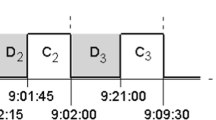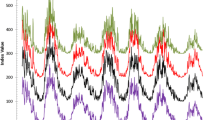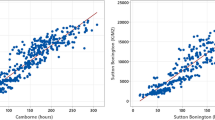Abstract
In this paper, we present a formalized approach to statistical modeling of the sunshine number, binary indicator of whether the Sun is covered by clouds introduced previously by Badescu (Theor Appl Climatol 72:127–136, 2002). Our statistical approach is based on Markov chain and logistic regression and yields fully specified probability models that are relatively easily identified (and their unknown parameters estimated) from a set of empirical data (observed sunshine number and sunshine stability number series). We discuss general structure of the model and its advantages, demonstrate its performance on real data and compare its results to classical ARIMA approach as to a competitor. Since the model parameters have clear interpretation, we also illustrate how, e.g., their inter-seasonal stability can be tested. We conclude with an outlook to future developments oriented to construction of models allowing for practically desirable smooth transition between data observed with different frequencies and with a short discussion of technical problems that such a goal brings.



Similar content being viewed by others
References
Akaike H (1974) A new look at the statistical model identification. IEEE Trans Automat Contr 19(6):716–723
Badescu V (1999) Correlations to estimate monthly mean daily solar global irradiation: application to Romania. Energy 24:883–893
Badescu V (2002) A new kind of cloudy sky model to compute instantaneous values of diffuse and global solar irradiance. Theor Appl Climatol 72:127–136
Badescu V, Dumitrescu A (2013) The CMSAF hourly solar irradiance database (Product CM54). Accuracy and bias corrections with illustrations for Romania (South-Eastern Europe). J Atmos Sol-Terr Phys 93:100–109
Badescu V, Paulescu M (2011a) Statistical properties of the sunshine number illustrated with measurements from Timisoara (Romania). Atmos Res 101:194–204
Badescu V, Paulescu M (2011b) Autocorrelation properties of the sunshine number and sunshine stability number. Meteorol Atmos Phys 112:139–154
Badescu V, Zamfir E (1999) Degree-days, degree-hours and ambient temperature bin data from monthly-average temperatures (Romania). Energy Convers Manage 40:885–900
Boland J (2008) Times series modeling of solar radiation. In: Badescu V (ed) Modeling solar radiation at the Earth surface. Springer, Berlin
Box GEP, Jenkins GM (1970) Time series analysis. Forecasting and control. Holden-Day, San Francisco
Chow CW, Urquhart B, Lave M, Dominguez A, Kleissl J, Shields J, Washom B (2011) Intra-hour forecasting with a total sky imager at the UC San Diego solar energy testbed. Sol Energy 85:2881–2893
Colin A, Trivedi P (1998) Regression analysis of count data. Cambridge University Press, Cambridge
DeltaOhm (2011) Pyranometers, albedometers, net irradiance meter. Manual. http://www.Deltaohm.Com/Ver2008/Uk/Pyra02.Htm. Accessed Dec 2011
Hastie TJ, Pregibon D (1992) Generalized linear models. In: Chambers JM, Hastie TJ (eds) Statistical models. Wadsworth & Brooks/Cole, Pacific Grove, California
Huang J, Korolkiewicz M, Agrawal M, Boland J (2013) Forecasting solar radiation on an hourly time scale using a Coupled AutoRegressive and Dynamical System (CARDS) model. Sol Energy 87:136–139
IEA (2007) Energy Technologies at the Cutting Edge. International Energy Agency, OECD Publication Service, OECD, Paris. http://www.iea.org/textbase/nppdf/free/2007/Cutting_Edge_2007_WEB.pdf. Accessed Dec 2011
Lara-Fanego V, Ruiz-Arias JA, Pozo-Vázquez D, Santos-Alamillos FJ, Tovar-Pescador J (2011) Evaluation of the WRF model solar irradiance forecasts in Andalusia (southern Spain). Sol Energy. doi:10.1016/j.solener.2011.02.014
Lorenz E, Remund J, Müller SC, Traunmüller W, Steinmaurer G, Pozo D et al (2009) Benchmarking of different approaches to forecast solar irradiance. In: Proceedings of the 24th European photovoltaic solar energy conference, Hamburg, Germany, pp 4199–4208
McCormick T, Raftery A, Madigan D (2011) Dynamic logistic regression and dynamic model averaging for binary classification. Biometrics 62:23–30
McCullagh P, Nelder JA (1989) Generalized linear models. Chapman and Hall, London
Mefti A, Adane A, Bouroubi MY (2008) Satellite approach based on cloud cover classification: estimation of hourly global solar radiation from METEOSAT images. Energy Convers Manag 49:652–659
Morf H (1998) The stochastic two-state solar irradiance model (STSIM). Sol Energy 62:101–112
NI (2011) Data acquisition with PXI and PXI express, National Instruments Corporation. http://www.ni.com/. Accessed Dec 2011
Nottrott A, Kleissl J (2010) Validation of the NSRDB–SUNY global horizontal irradiance in California. Sol Energy 84:1816–1827
Paoli C, Voyant C, Muselli M, Nivet ML (2010) Forecasting of preprocessed daily solar radiation time series using neural networks. Sol Energy 84(2010):2146–2160
Paulescu M, Badescu V (2011) New approach to measure the stability of the solar radiative regime. Theor Appl Climatol 103:459–470
R-core (2011) The comprehensive R archive network. http://cran.at.r-project.org/. Accessed Dec 2011
SRMS (2011) Solar radiation monitoring station of West University of Timisoara, Romania. http://solar.physics.uvt.ro/srms. Accessed Dec 2011
WMO (2008) Guide to meteorological instruments and methods of observation, WMO-No.8. http://www.wmo.int/. Accessed Dec 2011
Acknowledgments
The authors thank the reviewers for useful comments and suggestions. This work was supported in part by a grant of the Romanian National Authority for Scientific Research, CNCS-UEFISCDI, project number PN-II-ID-PCE-2011-3-0089, by the European Cooperation in Science and Technology project COST ES1002, by the Grant LD12009 (Ministry of Education, Young and Sports of the Czech Republic) and by the (Czech) Institutional Research Plan AV0Z10300504 “Computer Science for the Information Society: Models, Algorithms, Applications”.
Author information
Authors and Affiliations
Corresponding author
Additional information
Responsible editor: L. Gimeno.
Rights and permissions
About this article
Cite this article
Brabec, M., Badescu, V. & Paulescu, M. Nowcasting sunshine number using logistic modeling. Meteorol Atmos Phys 120, 61–71 (2013). https://doi.org/10.1007/s00703-013-0240-1
Received:
Accepted:
Published:
Issue Date:
DOI: https://doi.org/10.1007/s00703-013-0240-1




